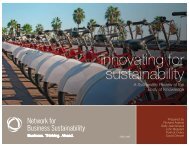embedding sustainability in organizational culture - Network for ...
embedding sustainability in organizational culture - Network for ...
embedding sustainability in organizational culture - Network for ...
Create successful ePaper yourself
Turn your PDF publications into a flip-book with our unique Google optimized e-Paper software.
Chapter 1: 5: Introduction Build<strong>in</strong>g Momentum <strong>for</strong> Change<br />
45<br />
Ask the big questions about where the organization should be <strong>in</strong> 10 to 20 years and<br />
start tak<strong>in</strong>g the necessary steps to get there. Look beyond current products and<br />
th<strong>in</strong>k about the value offered to customers (NBS, 2010). Use a reverse-eng<strong>in</strong>eer<strong>in</strong>g<br />
approach to develop a vision—start with the ideal and then work backwards<br />
(Doppelt, 2003). Dunphy and colleagues (2003) suggest imag<strong>in</strong><strong>in</strong>g several alternate<br />
future states and then us<strong>in</strong>g them to engage stakeholders <strong>in</strong> develop<strong>in</strong>g the paths to<br />
achiev<strong>in</strong>g them (Dunphy et al., 2003). Laszlo (2003) calls this a ‘susta<strong>in</strong>able value<br />
<strong>in</strong>tent,’ which allows executives to design a future state that is <strong>in</strong><strong>for</strong>med by the past<br />
but is not an extension of it.<br />
In the <strong>in</strong>novation literature, Mitleton-Kelly (2006) expla<strong>in</strong>s how back-cast<strong>in</strong>g<br />
allowed employees <strong>in</strong> one organization to ensure they built <strong>in</strong>novation <strong>in</strong>to all<br />
aspects of their work as they moved <strong>for</strong>ward. Each year, employees considered the<br />
organization, its practices and its <strong>culture</strong>, and were asked to <strong>in</strong>dicate changes that<br />
needed to be made to close the gap between where the organization was and where<br />
employees wanted it to be.<br />
While none of the research reviewed here explicitly explored how back-cast<strong>in</strong>g might<br />
help develop or support a <strong>culture</strong> of <strong>susta<strong>in</strong>ability</strong>, several sources suggested its<br />
value. More research is needed to understand the potential value of this practice.<br />
assessment: proposed but not tested<br />
share<br />
The practices <strong>in</strong> this category focus on shar<strong>in</strong>g <strong>in</strong><strong>for</strong>mation <strong>in</strong>ternally and/or<br />
externally with the aim of further<strong>in</strong>g the <strong>susta<strong>in</strong>ability</strong> agenda and work<strong>in</strong>g with<br />
other organizations to further a broader <strong>susta<strong>in</strong>ability</strong> agenda. At some po<strong>in</strong>t,<br />
organizations on the journey to <strong>susta<strong>in</strong>ability</strong> realize they are often fac<strong>in</strong>g issues that<br />
extend across departmental and even <strong>organizational</strong> boundaries. In try<strong>in</strong>g to address<br />
<strong>organizational</strong> issues, it may help to leverage <strong>in</strong>ternal and external networks and<br />
<strong>in</strong>corporate a variety of perspectives. Internal collaboration will allow employees to<br />
build on each other’s ideas and allow best practices to dissem<strong>in</strong>ate throughout the<br />
organization. Similarly, shar<strong>in</strong>g ideas and practices with other organizations can<br />
raise the <strong>susta<strong>in</strong>ability</strong> per<strong>for</strong>mance of everyone <strong>in</strong>volved. The practices discussed<br />
<strong>in</strong> this category are shar<strong>in</strong>g knowledge <strong>in</strong>ternally; shar<strong>in</strong>g knowledge externally; and<br />
collaborat<strong>in</strong>g with others.<br />
ShaRE knowlEdgE <strong>in</strong>tERnally: Make use of the organization’s diversity<br />
• Encourage shar<strong>in</strong>g of knowledge across different functional areas<br />
• Create cross-functional teams to work on <strong>susta<strong>in</strong>ability</strong> issues<br />
• Ensure <strong>in</strong>terdiscipl<strong>in</strong>ary representation when build<strong>in</strong>g work<strong>in</strong>g<br />
groups<br />
• Make use of the diversity of talents and ideas across your<br />
organization<br />
Innovations related to <strong>susta<strong>in</strong>ability</strong> often impact multiple areas of the organization.<br />
To understand how changes <strong>in</strong> one area may affect or even benefit other parts of the<br />
organization it’s a good idea to consult across functional areas. By ensur<strong>in</strong>g diverse<br />
functional representation <strong>in</strong> work<strong>in</strong>g teams, the organization will benefit from a<br />
range of perspectives. These diverse perspectives will allow <strong>for</strong> more susta<strong>in</strong>able<br />
solutions that accommodate a multitude of different expectations and requirements<br />
(Reverdy, 2006).<br />
One solution is to assemble <strong>in</strong>terdiscipl<strong>in</strong>ary and cross-functional teams to<br />
collaborate on <strong>susta<strong>in</strong>ability</strong> (NBS, 2010). Or, consider br<strong>in</strong>g<strong>in</strong>g together key people<br />
from across the organization <strong>in</strong> positions of responsibility where <strong>susta<strong>in</strong>ability</strong> can<br />
make a difference (Ethical Corporation, 2009). Willard (2009) proposes mobiliz<strong>in</strong>g<br />
commitment by cross-functional and cross-hierarchical team collaboration, and<br />
recommends establish<strong>in</strong>g <strong>for</strong>mal, cross-functional senior-level <strong>susta<strong>in</strong>ability</strong> teams<br />
that have the power to effect <strong>susta<strong>in</strong>ability</strong> trans<strong>for</strong>mation and the seniority to take<br />
accountability <strong>for</strong> it. Doppelt (2008) also suggests that organizations l<strong>in</strong>k people<br />
who are work<strong>in</strong>g on similar <strong>susta<strong>in</strong>ability</strong> <strong>in</strong>itiatives, <strong>for</strong> support and learn<strong>in</strong>g, to<br />
encourage <strong>in</strong>novation through collaboration. To keep <strong>culture</strong> <strong>in</strong> m<strong>in</strong>d, Strandberg<br />
(2009) recommends that the HR executive should be one of the members of the<br />
cross-functional team established to develop the CSR agenda.<br />
Rothenberg found that without deliberate ef<strong>for</strong>ts to coord<strong>in</strong>ate, environmental staff<br />
are often isolated and not <strong>in</strong>tegrated with the core of the organization, and have to<br />
work hard to develop closer relationships with other employees (Rothenberg, 2003).<br />
Reverdy (2006) observed that the lack of shared knowledge between environment<br />
and production staff resulted <strong>in</strong> misunderstand<strong>in</strong>gs and halted collaborative action<br />
and problem resolution.<br />
In a study of high-technology firms Jassawalla and Sashittal (2002) found that<br />
regular <strong>for</strong>mal meet<strong>in</strong>gs scheduled <strong>for</strong> the explicit purpose of shar<strong>in</strong>g <strong>in</strong><strong>for</strong>mation
















